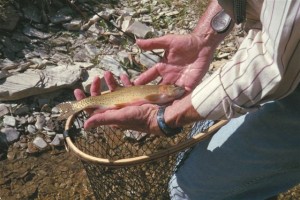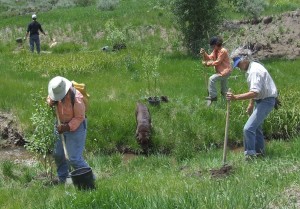If you have been wanting to volunteer with us, then here is your chance!! Below are some of the Volunteer Opportunities that we have coming up. If you are interested in any of these projects then please email Stephanie Scott directly at sscott@tu.org to sign up for one of the opportunities.
July Opportunities:
- July 16th - Josephine Falls Trail Decommission (partner with Cheyenne Mountain Chapter TU) - These work days will be from about 8:30-3:00. We will be working alongside of the Youth Core and other groups. We will meet in Colorado Springs and do a short car pool to the work area. From there we will hike in less than a mile to the work site. We will be using hand tools to loosen soil and remove evidence of the trail. We will also be moving brush and may do some plantings to cover the trail. These work days will be directed by the Rocky Mountain Field Institute (RMFI).
- July 18th-19th - Thunder/Box Lakes Gill Net Surveying (partner with Chris Kennedy in Rocky Mountain National Park) - Chris needs 2-3 people to help conduct gill net surveys on both of these lakes. Right now this is a full backpack trip and we will be camping at Thunder Lake (6.8 miles, 200 feet), but there is a cabin up there which Chris will try to get the use of. Chris has requested the use of the Thunder Lake cabin .
- July 22nd/July 23rd - Fence Repair (partner with Cheyenne Mountain Chapter TU)- Fence repair along the South Platte river in the South Park area (Hartsel). These work days will be from about 9:00 to 3:00. We will be working with CPW and other TU chapters. There are several State Wildlife Areas that are leased from private land owners. These land owners tend to graze cattle on their land. As part of the lease agreement CPW has constructed fences to keep livestock out of the riparian areas. CPW is charged with maintenance of these fences but does not have the manpower/budget to keep up with the work.
- July 23rd - S. Platte Musk Thistle Remediation (partner with Cutthorat Chapter TU) - Work days will be from 9:30 to 3:00, and meeting at 9AM near Deckers. This project is located right along the road and includes clipping and bagging musk thistle and severing its base at ground level. This will include no more than a half-mile hike at a your own pace, or you can travel by car. CUSP crew will remove the bagged thistle. Musk thistle is a noxious weed that outcompetes native plant species, becoming a monoculture when left untreated. This population is currently a threat to aquatic habitat, riparian grasses and insect populations. Musk thistle is a spikey plant so bring your favorite leather gloves, long sleeved shirts, and long pants. Deckers.
August Opportunities:
- August 13th - Colorado Trout Unlimited Outdoor Mentors Program - Chase Moore needs 1-2 volunteers to help with the CTU station. They will be teaching fly casting, tying and fish art. The event is from 9:00-2:00 at Barr Lake.
- August 20th - Horse Creek (partner with Cheyenne Mountain Chapter TU) - Work days will be from 9:30-3:00 and meeting at 9AM near Deckers. This work will include harvesting and transplanting willows, installing jute matting, raking and seeding native vegetation or planting trees along a two-mile stretch of Horse Creek, above it’s confluence with the South Platte. In-stream restoration work will occur at this location over the next two years to reduce sediment, replace damaged culverts and install bridges. The work will improve fish passage and habitat, as well as the safety of residents and visitors. This area of the Hayman burn scar continues to produce an excess of 65 tons of sediment annually into the South Platte River and continues to flood Highway 67. It is anticipated that this restoration will remove 50 to 55 tons annually, and is modeled after similar work – much of which included CCTU volunteers – that has successfully occurred in the higher Trail Creek drainage. As work progresses and the weather cools, project details will change, for example: willows can be transplanted at warmer temperatures than pine trees.
- August 30th-September 2nd - We will be in need of volunteers to help us fin clip rainbow X cutthroat hybrid trout at Mount Shavano Hatchery for our ongoing study comparing diploid versus triploid trout at Elevenmile Reservoir. This year we will be clipping fish August 30th – September 2nd and could use your help. Last year we clipped 68,000 fish in three days with the help of 70 people over the three day period. All of the work will take place outside at the Mount Shavano Hatchery in Salida. Parking will be available at the visitor parking area on the hill before you enter into the hatchery. We will plan on starting each day at 8 A.M. and should finish around 4:30 P.M. Volunteers should bring the following: Lunch, Water, Sunscreen, Chairs, Sunshades if available
September Opportunities:
- September 10th - CarpSlam - Denver TU is looking for volunteers to help with Pro/Am Carp Slam X on Sept 10,2016. The fishing venue will be 15 beats on the Denver South Platte River from Oxford downstream to 120th Ave. We are seeking people to work as Controllers and Rovers for the teams on the river. This is an opportunity to learn about fly fishing for carp and other species on the Platte for the smartest, slickest, smoothest anglers in the world. You should be in good physical condition and willing to work the full day from 7 AM to 5 PM. Lunch will be provided at Fuel Café. To volunteer please contact Mike Hobbs – CarpSlam Ops Manager – email: mhobbsco@gmail.com Volunteers will also receive swag and a ticket to the after party on the 14th floor of DaVita with one of the most spectacular views in Denver. Food, beer and wine will be served. Music provided by MTHDS. Tickets for the event are $35 presale and $45 at the door. For more info visit www.carpslam.org
- September 16th-18th - Girls Inc Fly Fishing Camp - This is a weekend commitment - still working on the details of the event and will post those once they are available.
- September 24th - This is the S. Platte River clean up - also still working on the details and will post once available.
Please RSVP for these events to Stephanie Scott sscott@tu.org






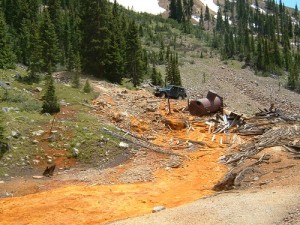 The estimated costs to clean up these sites range from $32-72 billion. Trout Unlimited initiated our Western Abandoned Hard Rock Mine Restoration Program in 2004 to both clean up problem mine sites that impact streams and fisheries, and to draw attention to the challenges associated with these efforts. From our innovative mine tailings revegetation projects addressing toxic mine tailings in Colorado to our successful floodplain restoration projects in Montana, Trout Unlimited has earned national recognition as the leading practitioner of Good Samaritan abandoned mine restoration in the country.
The estimated costs to clean up these sites range from $32-72 billion. Trout Unlimited initiated our Western Abandoned Hard Rock Mine Restoration Program in 2004 to both clean up problem mine sites that impact streams and fisheries, and to draw attention to the challenges associated with these efforts. From our innovative mine tailings revegetation projects addressing toxic mine tailings in Colorado to our successful floodplain restoration projects in Montana, Trout Unlimited has earned national recognition as the leading practitioner of Good Samaritan abandoned mine restoration in the country.
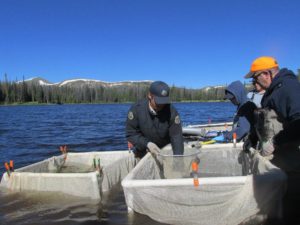


 Groups all over the state worked together to protect our state's water quality and our trout's quality of life. CTU hired water quality expert, Ashley Rust, as a consultant to provide technical support. Her work demonstrated flaws in the data selection and analysis used for the WQCD’s proposal. TU also worked with Colorado Parks and Wildlife scientists along with other organizations including Sierra Club, Colorado Wildlife Federation, CPW and EPA.
Groups all over the state worked together to protect our state's water quality and our trout's quality of life. CTU hired water quality expert, Ashley Rust, as a consultant to provide technical support. Her work demonstrated flaws in the data selection and analysis used for the WQCD’s proposal. TU also worked with Colorado Parks and Wildlife scientists along with other organizations including Sierra Club, Colorado Wildlife Federation, CPW and EPA.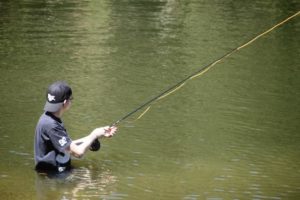 "Big thanks to John Woodling, who's testimony was a turning point in the hearing," said Whiting. "To Robin (Knox) who in 5 minutes conveyed a lifetime of experience- I loved the example of all the poor fish huddling in a small pool in the Yampa to avoid the hot water in response to the Division's callous assertion that if it's too hot, fish can just swim away. Big thanks to Dennis Buechler, who very softly and meekly brought in the impacts of these decisions on small businesses."
"Big thanks to John Woodling, who's testimony was a turning point in the hearing," said Whiting. "To Robin (Knox) who in 5 minutes conveyed a lifetime of experience- I loved the example of all the poor fish huddling in a small pool in the Yampa to avoid the hot water in response to the Division's callous assertion that if it's too hot, fish can just swim away. Big thanks to Dennis Buechler, who very softly and meekly brought in the impacts of these decisions on small businesses." Colorado River float trip: a full day float trip for two on the "lower Upper" Colorado River, above Dotsero. This float trip is with Jack Bombardier and Confluence Casting, who lives alongside the river and loves to share his "home waters" with new and returning visitors. Jack will take you on the Colorado River as it flows through one of the most colorful and beautiful canyons anywhere. On a typical float you might see bighorn sheep, eagles, dinosaur tracks, waterfalls and course lots of feisty trout. Best of all, since this section sees very little river traffic,there a good chance you 'll have it to yourselves! Learn more at the
Colorado River float trip: a full day float trip for two on the "lower Upper" Colorado River, above Dotsero. This float trip is with Jack Bombardier and Confluence Casting, who lives alongside the river and loves to share his "home waters" with new and returning visitors. Jack will take you on the Colorado River as it flows through one of the most colorful and beautiful canyons anywhere. On a typical float you might see bighorn sheep, eagles, dinosaur tracks, waterfalls and course lots of feisty trout. Best of all, since this section sees very little river traffic,there a good chance you 'll have it to yourselves! Learn more at the  Upper Gunnison River walk/wade trip: a full day walk/wade trip for two on public water in the upper Gunnison basin, operating from Three Rivers Resort in Almont with Willowfly Anglers, in the heart of one of Colorado's great fishing meccas picking up world-class angling options with the Gunnison, East, and Taylor Rivers. Operating for over 30 years, Willowfly offers experienced fly fishing guides, excellent private water options (available for an additional fee), as well as a full service fly fishing shop. Willowfly Anglers is the only Orvis Endorsed Outfitter in the Almont area and was recently named one of the top five Orvis Endorsed Outfitters in North America. Learn more at the
Upper Gunnison River walk/wade trip: a full day walk/wade trip for two on public water in the upper Gunnison basin, operating from Three Rivers Resort in Almont with Willowfly Anglers, in the heart of one of Colorado's great fishing meccas picking up world-class angling options with the Gunnison, East, and Taylor Rivers. Operating for over 30 years, Willowfly offers experienced fly fishing guides, excellent private water options (available for an additional fee), as well as a full service fly fishing shop. Willowfly Anglers is the only Orvis Endorsed Outfitter in the Almont area and was recently named one of the top five Orvis Endorsed Outfitters in North America. Learn more at the  Mely Whiting, lead negotiator for Trout Unlimited:
Mely Whiting, lead negotiator for Trout Unlimited: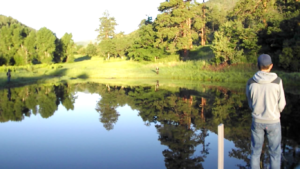 With many fish to be caught and much to be learned, the campers settled in to the barn that they would call home for the coming days. As the week progressed the campers gained experience in the worlds of conservation and fly fishing and made new connections with others who shared similar passions for the outdoors.
With many fish to be caught and much to be learned, the campers settled in to the barn that they would call home for the coming days. As the week progressed the campers gained experience in the worlds of conservation and fly fishing and made new connections with others who shared similar passions for the outdoors.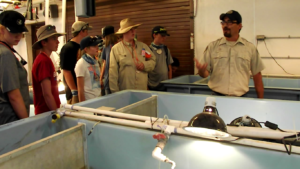 behind genetics, and were able to see what it takes to bring back a species from endangerment. Though the camp focuses on trout conservation, the hatchery harbors nothing but native species (meaning no trout), thus enabling campers to realize that conservation goes further than just the species most popular in Colorado rivers.
behind genetics, and were able to see what it takes to bring back a species from endangerment. Though the camp focuses on trout conservation, the hatchery harbors nothing but native species (meaning no trout), thus enabling campers to realize that conservation goes further than just the species most popular in Colorado rivers. restoration project in collaboration with the Purgatoire River Anglers Chapter of CTU out of Trinidad. The Purgatoire River runs through Trinidad and has seen many restoration efforts in the past few years. Campers assisted in the removal of a fern called Russian olive- an invasive plant that consumes large amounts of water, taking it away from the river system. A day was spent using tools and chainsaws to cut down many of these large plants to better the fishery that the anglers of Trinidad value greatly.
restoration project in collaboration with the Purgatoire River Anglers Chapter of CTU out of Trinidad. The Purgatoire River runs through Trinidad and has seen many restoration efforts in the past few years. Campers assisted in the removal of a fern called Russian olive- an invasive plant that consumes large amounts of water, taking it away from the river system. A day was spent using tools and chainsaws to cut down many of these large plants to better the fishery that the anglers of Trinidad value greatly. each day, and instruction from experienced guides and fishermen, campers enjoyed testing newly tied flies on eager fish. Astoundingly, at the end of five days, every young angler, regardless of skill level was able to successfully land a fish, with dozens of healthy trout seeing the net.
each day, and instruction from experienced guides and fishermen, campers enjoyed testing newly tied flies on eager fish. Astoundingly, at the end of five days, every young angler, regardless of skill level was able to successfully land a fish, with dozens of healthy trout seeing the net.